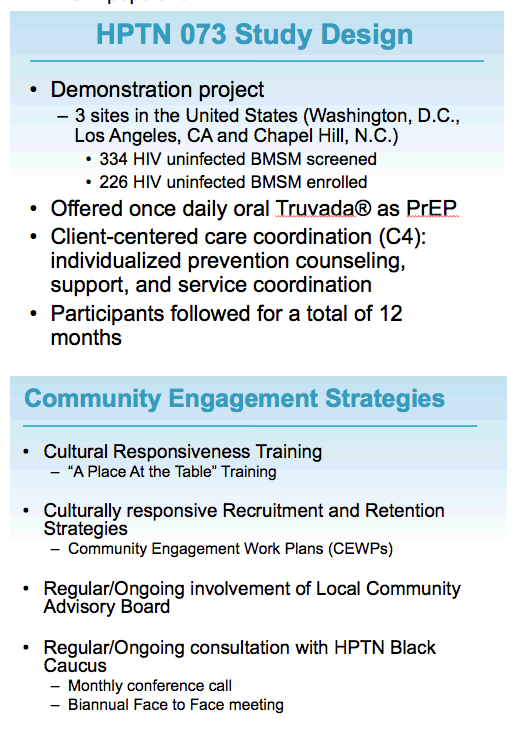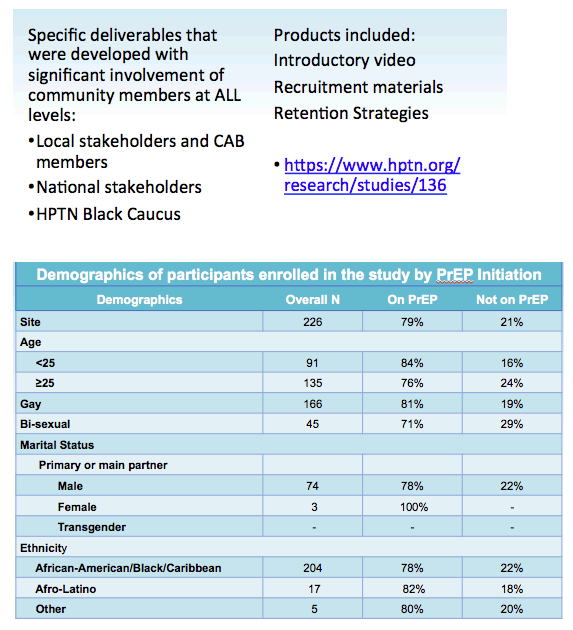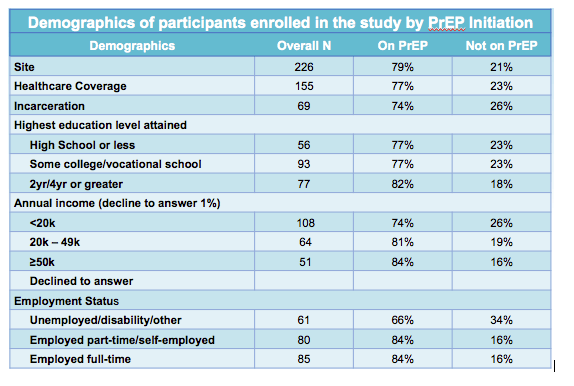 |
 |
 |
| |
HPTN 073: successful engagement of Black MSM into a culturally relevant clinical trial for pre-exposure prophylaxis (PrEP)
|
| |
| |
Reported by Jules Levin
Durban 2016 July 18-22
Presenter
Christopher Hucks-Ortiz
Authors
C. Hucks-Ortiz1, J.P. Lucas2, D.P. Wheeler3, S.D. Fields4, The HPTN Black Caucus
Institutions
1John Wesley Community Health Institute Inc. (JWCH), Division of HIV Services, Los Angeles, United States, 2FHI 360, Science Facilitation Department, Durham, United States, 3University at Albany State University of New York, Vice Provost for Public Engagement, Dean School of Social Welfare, Albany, United States, 4Charles R Drew University of Medicine and Science, Mervyn M. Dymally School of Nursing, Los Angeles, United States

ABSTRACT
Background: In the United States, Black men who have sex with men (BMSM) continue to be disproportionately impacted by high HIV incidence rates. Comprising less than 0.4% of the U.S. population, BMSM accounted for more than 20% of new HIV infections in 2013. Identifying innovative and effective methods to deliver culturally-tailored prevention methods to end this epidemic among BMSM is a public health priority. HPTN 073 is one of the first U.S. studies to evaluate pre-exposure prophylaxis (PrEP) in a BMSM cohort.
Methods: HIV-uninfected BMSM were enrolled in three U.S. cities (Washington, DC, Los Angeles, CA, and Chapel Hill, NC). Under the study motto “My Life, My Health, My Choice” all participants were offered once daily oral FTC/TDF combined with client-centered care coordination (C4). The C4 model provided counseling support to promote and support PrEP use, along with service referral, linkage, and follow-up strategies to assist participants in addressing unmet psychosocial needs. Each participant was followed for a total of 12 months.
Results: All of the staff at the three sites were asked to participate in cultural responsiveness training as a part of implementation activities, and then utilized a variety of culturally relevant recruitment and retention techniques such as webinars, street and online outreach, peer-to-peer engagement, and partnerships with community service organizations. 344 BMSM were screened and 226 were enrolled in HPTN 073. 209 (92%) participants completed 12 months of follow-up. 40% were age 25 or less, 27% unemployed/disabled, 31% did not have health insurance, 25% reported high school graduation or less. 178 men (79%) accepted PrEP over the course of the study.
Conclusions: HPTN 073 demonstrated that BMSM can be successfully recruited, engaged, enrolled and retained in PrEP biomedical clinical trials using theory-based culturally tailored techniques. HPTN 073 provides a model for how best to integrate culturally-specific recruitment approaches when targeting communities at risk for HIV acquisition. Utilizing theory-based culturally tailored programs for BMSM that are reflective of their reality is key to reaching this highly at risk population of MSM who can benefit from the new HIV prevention biomedical advances.




|
| |
|
 |
 |
|
|